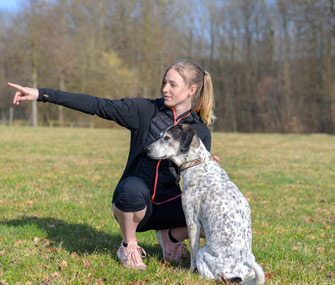Teach Your Dog to “Look” on Command
Published on April 25, 2017
Skip To

If your dog’s curiosity is slowing down your walks, there’s a solution. Training your dog to “look” on command can help keep him focused on where he’s going without missing any of the excitement that’s happening around him.
Training your dog to look in the direction of something novel, interesting or possibly even slightly unnerving may sound nonsensical. Why draw your dog’s attention to something that may excite or even upset him? When you teach your dog to “look,” you also train him to return his attention to you. This can help to make novel situations more predictable and give your dog a way to focus and avoid overreacting to something that might be scary or stressful — or just super exciting — for him.
Look Over There!
Hold an object your dog will be interested in — like a chew toy or a ball — behind your back, where your dog cannot see it. A toy with a squeaker or rattle can be helpful for catching your dog’s attention. You can also wiggle or wave the toy gently to catch his eye.Ask your dog to look at you; once he is making eye contact, pull the hidden item out and hold it out to your side, away from where your dog is looking. Immediately mark and reward any glance or movement your dog makes in the direction of the object.
When you reward him, give the treat in such a way that your dog has to turn back toward you (and away from the exciting toy) to get his reward. To do this, hold the treat directly in front of your legs, at the level of the dog’s nose. This helps to reinforce the idea of looking at something and then shifting attention back to you, which is exactly what you’re trying to teach him.
Next, add a verbal cue — “look” — to the behavior. Say the word just as your dog starts to turn his head in the direction of the item. You can also watch your dog’s body language and note when he’s getting ready to turn toward the object. Eventually, you want to be able to use the “look” cue to point out interesting things before your dog sees them for himself.
Make “Look” Work in Real Life
Once your dog is consistently responding to the “look” cue, continue to work on getting him to return his gaze to you before being rewarded. Instead of marking when your dog looks at the item, wait for him to return his gaze to you before marking and rewarding. Many times simply delaying the marker signal will encourage your dog to look back on his own. A small prompt like a kissing noise can also be used to redirect your dog’s attention away from the item and back to you. Reward him as soon as he looks at you.When your dog is consistently responding to the “look” with small handheld items — and is returning his attention to you before he is rewarded — you can start to practice in increasingly distracting environments and real-life situations. Gradually accustom your dog to responding to “look” in scenarios where it’s especially important for him to focus on you — for example, when people or dogs are passing near you on a walk. Practice with your dog in situations where he can remain calm; for example, start by having a familiar person walk past you on the sidewalk as you give the command to “look,” rather than doing this when a stranger passes.
Eventually, fade the toy or ball and use your hand to point to things your dog might find interesting, like a child on a bike or a passing car. Give the cue and point toward the object; when your dog returns his gaze to you, praise and reward him.
With time and practice, your dog should learn to respond to the “look” cue even in very high distraction situations. Be patient in your training and make sure that your dog is relaxed and comfortable as you practice this trick.
More on Vetstreet:





